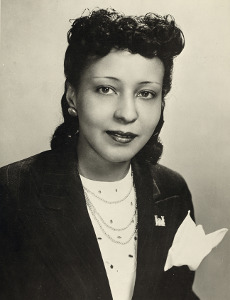Ruby Hurley facts for kids
Quick facts for kids
Ruby Hurley
|
|
|---|---|
 |
|
| Born |
Ruby Ruffin
November 7, 1909 Washington, D.C., United States
|
| Died | August 9, 1980 (aged 70) Atlanta, Georgia, United States
|
| Alma mater | Miner Teachers College University of the District of Columbia Robert H. Terrell Law School |
| Known for | Civil rights activism |
| Spouse(s) | William L. Hurley |
Ruby Hurley (November 7, 1909 – August 9, 1980) was an important American civil rights leader. She worked for the NAACP. Many people called her the "queen of civil rights" because of her strong efforts. She helped fight for equal rights for African Americans.
Contents
Ruby Hurley's Early Life and Education
Ruby Ruffin was born in Washington, D.C. on November 7, 1909. Her parents were Alice and Edward R. Ruffin. After finishing Dunbar High School in 1926, she went to college. She studied at Miner Teachers College and Robert H. Terrell Law School.
Ruby worked for a short time for the government and at a bank. In 1942, she married William L. Hurley, who was in the US Army. They later separated in 1952.
Helping Marian Anderson Sing
In 1939, Ruby Hurley joined a special group. Their job was to help Marian Anderson, a famous African-American singer. Marian Anderson was not allowed to sing at a place called Constitution Hall. This was because of her race.
Ruby's group helped find a new place for Marian to sing. She performed outdoors at the Lincoln Memorial. About 75,000 people came to listen to her. This event showed how important it was to fight for fairness.
Ruby Hurley's Work with the NAACP
For four years, Ruby Hurley worked to make the NAACP stronger in Washington, D.C. She especially helped their youth groups. In 1943, Walter Francis White, who led the NAACP, made Ruby the national Youth Secretary. She moved to New York City and stayed in this role until 1950.
Opening an Office in the South
In 1951, Ruby moved to Birmingham, Alabama. Her job was to open an NAACP office there. This office would help people in states like Tennessee, Mississippi, Alabama, Georgia, and Florida. It was the first permanent NAACP office in the Deep South. This was a very important step for the civil rights movement.
The next year, she became the Regional Secretary for the new Southeast Regional Office.
Investigating Important Cases
In 1955, Ruby Hurley worked with other civil rights leaders. These included Amzie Moore and Medgar Evers. They investigated the sad murders of a minister named George W. Lee and a 14-year-old boy named Emmett Till. To talk to people who saw what happened in Emmett Till's case, Ruby dressed like a cotton picker. This helped her gather information safely.
After the Brown v. Board of Education decision in 1954, Ruby worked hard. This court ruling said that schools could not be separated by race anymore. Ruby helped make sure this rule was followed in the South.
Facing Challenges and Threats
Ruby Hurley believed in peaceful ways to make change. But she was also very brave. In 1955, she was on the cover of Jet magazine. The magazine called her the "Most Militant Negro Woman In The South."
In 1956, Ruby helped Autherine Lucy try to attend the University of Alabama. Ruby faced many dangers because of her work. People were very mean to her. Her house was attacked, and she got bad phone calls. After a riot at the University of Alabama, Black taxi drivers helped protect her home.
Moving to Atlanta
On June 1, 1956, Ruby had to leave Alabama quickly. The state stopped the NAACP from working there. She moved to Atlanta and opened a new office four months later. This office became a key place for civil rights leaders. Ruby worked with people like Vernon Jordan.
Ruby and her team also helped Charlayne Hunter-Gault and Hamilton E. Holmes. They helped them get into the University of Georgia in 1961. After Medgar Evers was killed in 1963, Ruby convinced his wife, Myrlie, to bury him at Arlington National Cemetery.
Ruby Hurley's Legacy
Ruby Hurley retired on March 31, 1978. She passed away on August 9, 1980, in Atlanta.
People still remember Ruby Hurley's important work. The Chattanooga–Hamilton County NAACP has an annual award named after her. In 2009, Ruby Hurley was honored on a 42-cent stamp, along with Ella Baker.

